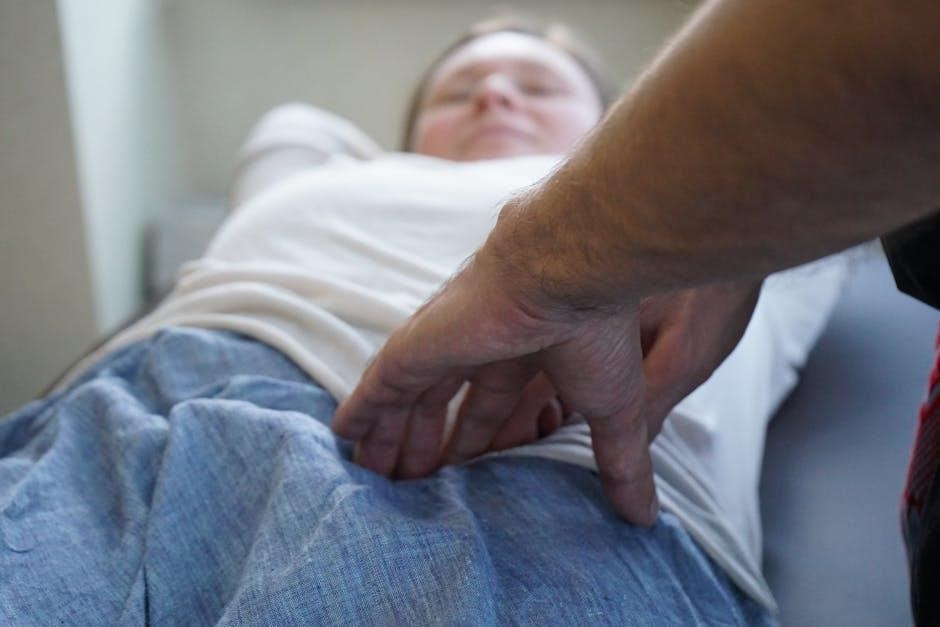Overview of Spondylolisthesis and Physical Therapy
Spondylolisthesis involves a vertebra slipping forward, causing pain and instability․ Physical therapy is a cornerstone in managing this condition, especially for mild cases, aiming to reduce pain and improve function without surgery․ A tailored protocol addresses core strengthening, flexibility, and proper posture, enhancing overall spinal stability and preventing progression․
1․1 Definition and Types of Spondylolisthesis
Spondylolisthesis is a condition where a vertebra slips forward relative to the one below it, often causing spinal instability․ It is graded I to IV based on the degree of slippage, with Grade I being less than 25% and Grade IV indicating severe displacement․ The condition can be congenital, degenerative, traumatic, or due to a defect like spondylolysis․ Understanding the type and grade is crucial for developing an effective physical therapy plan․
1․2 Importance of Physical Therapy in Managing Spondylolisthesis
Physical therapy is vital for managing spondylolisthesis, focusing on pain reduction, improving function, and preventing progression․ It avoids surgery for mild cases, emphasizing core strengthening, flexibility, and posture․ A personalized approach addresses muscle imbalances, enhances spinal stability, and promotes long-term management․ Therapy also educates patients on proper mechanics, reducing recurrence and improving quality of life, making it a cornerstone of conservative treatment․

Assessment and Diagnosis in Physical Therapy Protocol
Assessment involves clinical evaluation, patient history, and imaging to confirm diagnosis and severity․ X-rays and MRIs are used to grade the slip and guide treatment plans effectively․
2․1 Clinical Evaluation and Patient History
A thorough clinical evaluation begins with a detailed patient history, focusing on pain onset, severity, and activity-related symptoms․ Assessing mechanical symptoms, such as pain during hyperextension, is crucial․ The physical therapist evaluates posture, movement patterns, and palpation for tenderness․ Patient history reveals prior injuries, repetitive stress, or genetic predispositions․ This information, combined with imaging results, guides the development of a personalized treatment plan tailored to the patient’s specific condition and functional goals․
2․2 Imaging and Diagnostic Criteria for Spondylolisthesis
Imaging is critical for diagnosing spondylolisthesis, with X-rays, MRIs, and CT scans commonly used to confirm vertebral slippage․ The Meyerding grading system categorizes severity from grade I (≤25% slippage) to grade V (complete displacement)․ Imaging helps identify nerve compression and degenerative changes․ Physical therapy is often recommended for grades I and II, while higher grades may require surgical intervention․ Accurate imaging ensures appropriate treatment planning and monitoring of progression․

Phases of Rehabilitation in Spondylolisthesis
Rehabilitation progresses through acute, subacute, and advanced phases, focusing on pain management, strengthening, and functional restoration to safely return to activities and sports․
3․1 Acute Phase: Pain Management and Stabilization
The acute phase focuses on reducing pain and inflammation, often through rest, ice, and medication․ Gentle exercises like pelvic tilts and breathing techniques are introduced to maintain mobility without aggravating the condition․ Manual therapy, such as soft tissue mobilization, may be used to alleviate muscle tension․ The goal is to stabilize the spine and prepare the patient for more active rehabilitation in subsequent phases, ensuring a foundation for recovery․
3․2 Subacute Phase: Strengthening and Flexibility
The subacute phase emphasizes strengthening the core, glutes, and hamstrings to enhance spinal stability․ Gentle exercises like planks, bird-dog, and glute bridges are introduced․ Flexibility exercises target tight muscles, such as hip flexors and hamstrings, to improve range of motion․ Low-impact aerobic activities, like cycling, may be added to boost cardiovascular fitness․ The focus is on progressive resistance to build strength without exacerbating the condition, ensuring proper technique to avoid re-injury․
3․3 Advanced Phase: Functional Restoration and Return to Activity
The advanced phase focuses on restoring functional abilities and safely returning to prior activities or sports․ Dynamic exercises, such as single-leg stands and balance drills, improve proprioception․ Sport-specific or job-related movements are incorporated to mimic real-life demands․ Core stability and proper movement mechanics are reinforced to prevent recurrence․ Gradual progression ensures the individual can perform tasks without pain or instability, achieving full functional recovery and confidence in daily or athletic activities․

Core Strengthening and Stabilization Exercises
Core strengthening targets abdominal and back muscles to enhance spinal stability and reduce pain in spondylolisthesis patients․ Exercises like planks and bridges are used to improve strength and promote proper posture, preventing further slippage and supporting long-term recovery․
4․1 Anti-Extension and Anti-Rotation Exercises
Anti-extension and anti-rotation exercises are crucial for stabilizing the trunk in spondylolisthesis patients․ These exercises, such as planks, bird dogs, and side plank variations, target the transverse abdominis and obliques to enhance spinal stability․ By minimizing excessive spinal movement, they reduce the risk of further vertebral slippage and alleviate pain․ Progression to dynamic movements, like rotational exercises with controlled resistance, helps improve functional strength and neuromuscular control, essential for long-term stability and injury prevention․
4․2 Closed-Chain Gluteal Strengthening Techniques
Closed-chain exercises, such as squats, lunges, and step-ups, are effective for strengthening the glutes in spondylolisthesis patients․ These exercises enhance hip and pelvic stability without putting excessive strain on the spine․ Bodyweight squats and side-step band walks improve gluteal activation, crucial for reducing lumbar stress․ Progression to weighted exercises, like goblet squats, further builds strength․ These techniques promote functional movement patterns, aiding in the restoration of proper biomechanics and reducing the risk of exacerbating the condition․

Manual Therapy Techniques in Spondylolisthesis Rehabilitation
Manual therapy, including soft tissue mobilization and spinal manipulation, aims to reduce pain, improve joint mobility, and restore proper spinal mechanics in spondylolisthesis patients․
5․1 Soft Tissue Mobilization and Spinal Manipulation
Soft tissue mobilization targets paraspinal muscles, quadratus lumborum, gluteals, and piriformis to reduce tension and improve flexibility․ Spinal manipulation enhances joint mobility and reduces pain, aiding in restoring proper spinal mechanics and alignment․ These techniques are integral to addressing muscle imbalances and promoting a stable environment for healing in spondylolisthesis rehabilitation․
5․2 Thoracic Spine Mobilization and Hip Flexor Stretching
Thoracic spine mobilization enhances upper spinal flexibility, reducing compensatory lumbar strain․ Hip flexor stretching addresses tightness that exacerbates spondylolisthesis-related discomfort․ These techniques improve posture, reduce muscle imbalances, and promote overall spinal alignment, aiding in pain reduction and functional improvement during rehabilitation․

Home Exercise Program and Patient Education
A personalized home exercise program empowers patients to manage spondylolisthesis independently․ Education on proper back mechanics and posture prevents recurrence and enhances long-term functional outcomes effectively․
6․1 Designing a Personalized Home Exercise Routine
A personalized home exercise routine for spondylolisthesis focuses on core strengthening, flexibility, and proper posture․ Exercises like anti-extension and anti-rotation movements, closed-chain gluteal strengthening, and functional activities such as side-step band walks, goblet squats, and single-limb exercises are often included․ The program is tailored to the patient’s specific needs, progression, and daily activities, ensuring adherence and effectiveness in managing symptoms and improving spinal stability over time․
6․2 Teaching Proper Back Mechanics and Posture
Teaching proper back mechanics and posture is crucial for managing spondylolisthesis․ Patients are educated on neutral spine positioning, body mechanics during lifting, and posture awareness to reduce strain on the lower back․ Exercises focusing on muscle balance, such as strengthening core muscles and stretching tight hip flexors, are emphasized․ Proper posture practices help minimize pain, prevent progression, and enhance spinal stability, supporting long-term management and functional activities․

Progression Criteria and Return to Sport/Activity
Progression criteria include pain reduction, improved strength, and functional ability․ Gradual reintroduction to activities focuses on maintaining proper mechanics and avoiding exacerbating movements, ensuring safe return․
7․1 Functional Assessments and Outcome Measures
Functional assessments evaluate strength, flexibility, and movement patterns to track progress․ Outcome measures include pain levels, range of motion, and functional ability improvements․ Specific exercises like anti-extension and anti-rotation are used to ensure stability․ Progression criteria include consistent pain reduction, improved strength, and the ability to perform daily or sport-specific tasks without exacerbation․ These assessments guide safe and effective return to activity, ensuring optimal recovery and minimizing recurrence risk․
7․2 Gradual Reintegration into Sports or Daily Activities
Gradual reintroduction to sports or daily activities occurs after achieving stability and strength․ Progression criteria include consistent pain reduction, improved strength, and task performance without discomfort․ Activities begin with low-impact exercises like gentle stretching and core stabilization, advancing to dynamic movements․ The therapist tailors the program to individual responses, ensuring a safe and effective return to full activity, minimizing recurrence risk․
8․1 Summary of Key Rehabilitation Principles
Physical therapy for spondylolisthesis focuses on core strengthening, flexibility, and proper posture to enhance spinal stability․ Key principles include anti-extension and anti-rotation exercises, closed-chain gluteal strengthening, and patient education on back mechanics․ Progression through rehabilitation phases ensures pain reduction, functional restoration, and return to activity․ A personalized approach, adhering to evidence-based protocols, is essential for optimal outcomes and long-term management․
8․2 Importance of Long-Term Compliance and Preventative Care
Long-term compliance with prescribed exercises and preventative strategies is crucial for managing spondylolisthesis․ Regular core strengthening, proper posture, and avoiding aggravating activities help prevent progression․ A home exercise program and patient education empower individuals to maintain spinal stability and reduce recurrence risk․ Consistent adherence to rehabilitation principles ensures sustained improvement and enhances quality of life, making long-term compliance essential for optimal outcomes․
